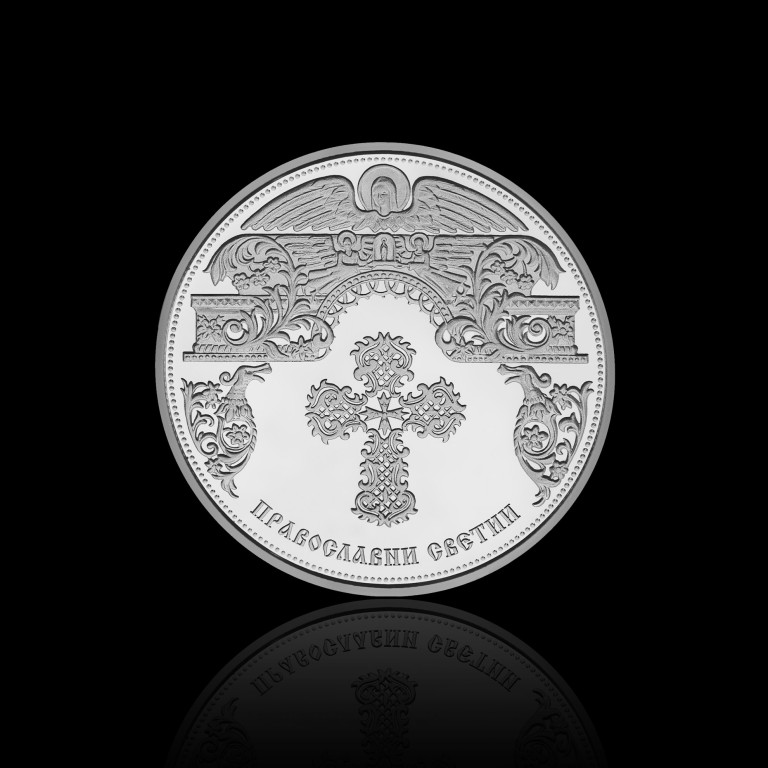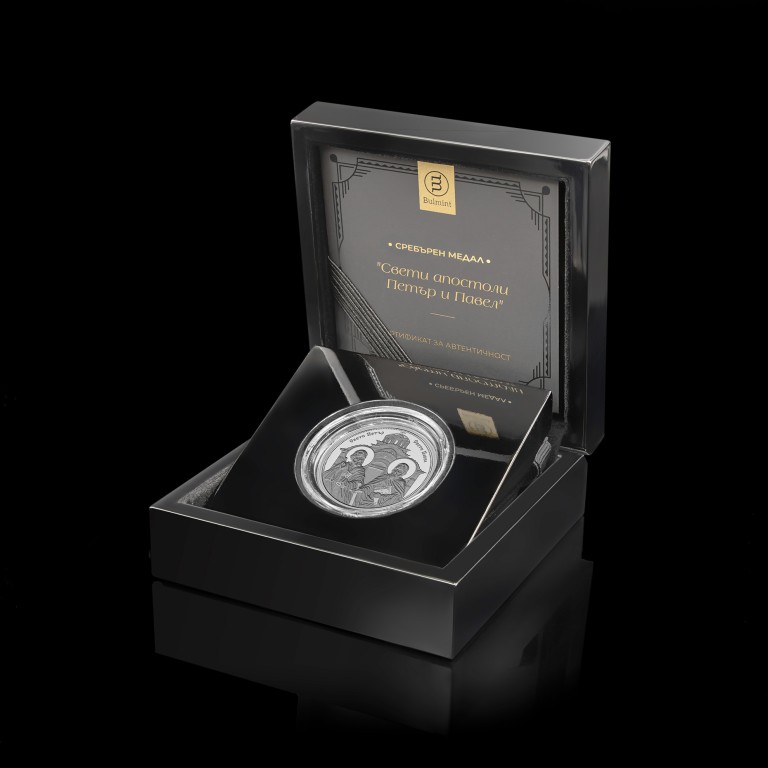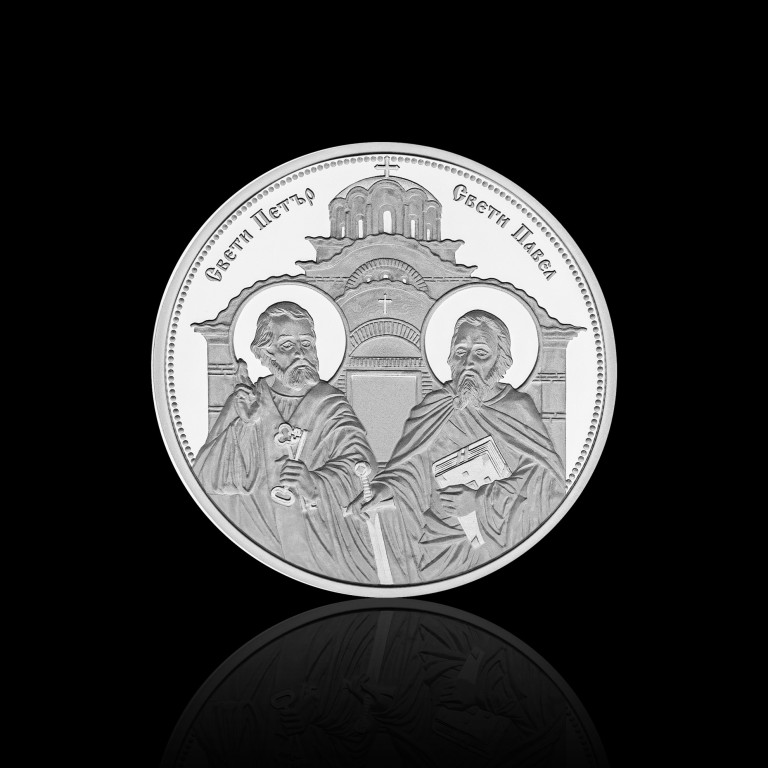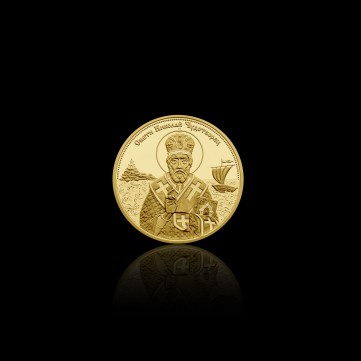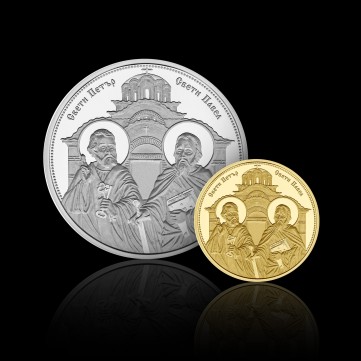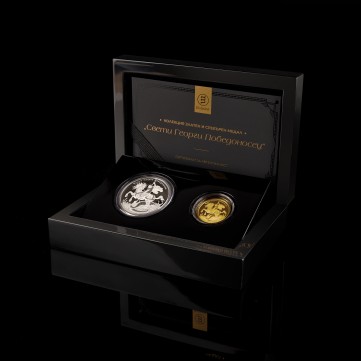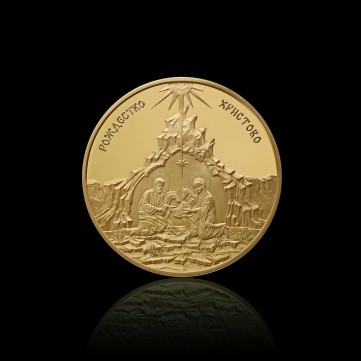Holy Apostles Peter and Paul Silver Medal, 31.1 g
260.00 BGN / 132,94 €Minted from 31.1 g of 999.9 fine silver in proof matt-gloss quality, this medal is a precious and original gift for a name day or another occasion. It is inspired by traditional Orthodox iconography depicting the holy foremost apostles Peter and Paul.
On June 29 the Orthodox church honours two saints – the most revered of the apostles for their contribution the spread of the Christian faith, Peter and Paul. Although different in their origin, role in the early history of the religion, and even in their world views, they are held in equally high regard as cornerstones of Christianity. The fourth collection in the “Orthodox Saints” program is dedicated to the holy apostles Peter and Paul.
The “Holy Apostles Peter and Paul” silver medal is minted in proof matt-gloss quality from 31.1 grams (1 troy ounce) of 999.9 fine silver in a diameter of 38.6 mm. Select details from the composition stand out thanks to the satin and laser polished finishes. The product comes in a black wooden box decorated with Bulmint’s logo. The raisable platform inside this elegant accessory makes it suitable for both storage and display. The product is a precious addition to a personal collection, a symbol of faith, and an original gift for a name day or another occasion.
The obverse depicts them standing in front of a church – a realistic reference to the most widespread type of icon dedicated to the two apostles and a visual representation of their role as “pillars of the Christian church”. The architecture is based on the main church of the Lozen Monastery of Saints Peter and Paul by Sofia, Bulgaria.
Saint Peter is holding а pair of keys – one gold, here represented through a satin finish, and one silver, here laser engraved for greater contrast. They are emblematic of iconographic depictions of the first leader of the Christian church – a visual representation of the words with which Jesus Christ left his legacy to his disciple: "I will give you the keys of the kingdom of heaven, and whatever you bind on Earth shall be bound in heaven, and whatever you loose on Earth shall be loosed in heaven." (Matthew 16:19). His right hand is raised in a gesture of blessing.
Saint Paul is holding a sword – a symbol of his martyrdom – and a book containing his 14 epistles included in the New Testament.
The reverse of the “Orthodox Saints” program is inspired by the richly ornamented iconostasis from the Nativity of the Blessed Virgin Mary Church in Rila Monastery, made between 1839 and 1844 by Atanas Teladur, the founder of this art movement of the Samokov Art School. To complete the composition at its centre we depicted an Orthodox cross faithful to the style of the iconostasis.
The motif is available on a 7.78 g gold medal, and you can buy the whole Holy Apostles Peter and Paul collection in a double box.
Metal
Fine Silver
Weight
31.1
g
Purity
999.9/1000
Edging
Smooth
Quality
Proof
Circulation
3000
pcs.
Diameter
38.6
mm
Saint Peter
Born Simon and later receiving the name Peter (“rock” in Greek), he was one of Christ’s twelve disciples. He hailed from a poor family and together with his brother Andrew was among the first to be chosen as a follower of the Saviour. Peter was the one to recognise and name Jesus as more than a prophet - “Son of the Living God”. For this realisation, sent to him by God Himself, Jesus calls him the rock upon which He would build His church and symbolically gives him the keys of Heaven. Catholics consider the pope the successor to Saint Peter, which in the minds of some makes the apostle the first pope.
In life Saint Peter was kind of heart, but despite his loyalty to Jesus, his story has moments of weakness, followed by repentance. On the eve of His arrest, Christ told him that before the rooster crowed, he would have denied his teacher three times. Peter himself asserted that he would choose death over this betrayal – but when Jesus’ words come to pass, he instantly saw the gravity of his sin and wept bitter tears of remorse.
After His Resurrection, the Saviour asked Peter three times whether he loved Him, and three times the apostle affirmed that he did, gaining absolution. It was here that Jesus affirmed him as the prime shepherd of His flock.
Apostle Peter continued Christ’s work, spreading the new faith throughout the known world. He was sentenced to death by Emperor Nero and is crucified in Rome in 67 AD – but, per his own request, upside down, as he did not believe himself worthy of suffering the same death as Christ.
Saint Paul
Paul the apostle began his story not as a disciple of Christ or even a follower of his teachings, but as a relentless persecutor of Christians. He was a highly educated man of Jewish descent and with Roman citizenship, born to a wealthy family. He was among those who supported the martyrdom of Saint Stephen.
At the peak of his persecution efforts, Christ himself appeared to him in a dream. This marked a turn in his life – he converted to Christianity and dedicated his life to the mission of spreading God’s word not only among the Jews, but among gentiles as well. With the suffering he bore during his missionary years, he gained absolution from his prior sins. He authored 14 epistles – messages to those new to the faith which are now part of the New Testament.
Much like Saint Peter, he was put on trial around the year 67 AD. His Roman citizenship granted him death by beheading – for that reason he is often depicted holding the weapon of his demise or with his fourteen epistles, either compiled in a book or represented as a set of scrolls.
Feast and veneration
The Orthodox church honours these very different holy men on June 29. Their contribution to the spread of Christianity has elevated them to the status of “foremost apostles”. Their feast is preceded by the strict Fast of Peter and Paul that begins after Pentecost.
According to Bulgarian folk beliefs, Peter and Paul are brothers or even twins. In some cases they are venerated as two inseparable parts of one whole, but in some parts of the country they are celebrated on two consecutive days – Saint Peter’s Day on June 29 and Saint Paul’s Day on June 30. Their feasts are accompanied by customs and rituals that are believed to ward off fires, thunderstorms, and hailstorms.
We dedicated this program to the saints thousands of Christians turn to with prayers of good health and protection, aid and spiritual guidance. It will consist of 12 medal collections dedicated to 12 holy men and women central to Eastern Orthodox Christianity. Each motif will be struck to proof matt-gloss quality onto two medals made of the finest gold and silver.
The number 12 itself is steeped in symbolic meaning - it bears significance in every corner of the world and in more than one religion or culture. That is how many months there are in a year according to most calendars. Its significance is especially pronounced in the Christian Bible. There are twelve holy apostles in the New Testament - chosen confidants and students of Jesus Christ, who were the ones to spread his gospel. The days between the Nativity of Christ and Epiphany are also twelve. Eastern Orthodox Christianity observes twelve Great Feasts - each dedicated to a pivotal moment in the life of Jesus Christ or the Virgin Mary, second in significance only to Easter.
The reverse design shared by the medals in this collection draws inspiration from the gilded iconostasis from the Nativity of the Blessed Virgin Mary Church in Rila Monastery - a composition of richly ornamented woodcarvings depicting floral ornaments, stylised animals and angels. This iconostasis was made between 1839 and 1844 by the master woodcarver Atanas Teladur, founder of the woodcarving movement of the Samokov Art School.
The iconostasis holds a place of high importance in interior church architecture - it represents the divide between Heaven and Earth. It acts as a partition between the altar, to which only members of the clergy have access, and the congregation. It is also the frame upon which the majority of the church icons are hung. The Orthodox churches of Bulgaria, particularly the ones from the National Revival Period, are known for their intricate handcarved wooden iconstases, each steeped in Christian symbolism and local folk motifs.
We ship our orders with Econt Express. The cost of delivery is at the customer's expense and includes insurance, cash on the delivery fee, if applicable, and courier service. The total delivery cost is formed based on the chosen method of payment and the method of delivery.
Orders received by 3 p.m. on working days and chosen payment method cash on delivery or credit card are processed and shipped on the same day. Orders received after 3 p.m. or during the weekend, are processed and dispatched on the next working day.
Each shipment has the "Check" option. In case the customer decides to return the order, the delivery and return costs are at the expense of the customer.
Product is out of stock
Enter your e-mail address and we will notify you when the product is back in stock.

